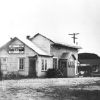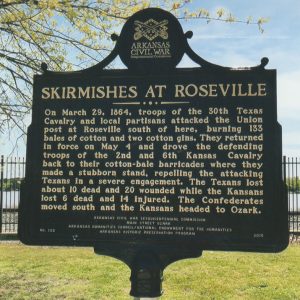calsfoundation@cals.org
Skirmishes at Roseville
| Location: | Roseville (Logan County) |
| Dates: | March 29, 1864; April 4, 1864 |
| Campaign: | Camden Expedition |
| Principal Commanders: | Captain John Gardner (US); Colonel Nicholas Battle (CS) |
| Forces Engaged: | Companies D and E, Second Kansas Cavalry, Company D, Sixth Kansas Cavalry (US); Thirtieth Texas Cavalry (CS) |
| Estimated Casualties: | 6 dead, 14 wounded (US); 6 to 10 dead, 20 wounded (CS) |
| Result: | Confederate victory (March 29), Union victory (April 4) |
In late March 1864, Companies D and E of the Second Kansas Cavalry, led by Captain John Gardner of Company E, were dispatched from their post at Jenny Lind (Sebastian County) to protect Union supplies and a cache of cotton at Roseville (Logan County). Roseville, which was at that time in Franklin County, was an important port on the Arkansas River, forty-five miles southeast of Fort Smith (Sebastian County). The companies either joined or were joined by Company D of the Sixth Kansas Cavalry, making a force of about 200 men. At about the same time, Confederate brigadier general Samuel Bell Maxey ordered Colonel Nicholas Battle to take a detachment of 400 to 500 men of his Thirtieth Texas Cavalry “to proceed to Roseville, Ark., destroy all cotton and commissary stores and the grounded boats, producing as much consternation by a movement of this kind in rear as possible,” as Maxey led other Texas troops into southwestern Arkansas to confront Union major general Frederick Steele’s invasion of the area.
On March 29, 1864, a party of Confederates—probably a mix of Battle’s Texans and local partisans—attacked the Union post at Roseville, burning 133 bales of cotton and destroying two cotton gins before the Kansas cavalrymen and local Unionists drove them away from town. No casualties were reported in this skirmish.
Battle returned and attacked in force on April 4, driving the Kansas troops back to their cotton bale barricades on the Arkansas River, where they made a stubborn defense. After a severe engagement, the Texans were driven from the field, having lost between six and ten men killed and around twenty wounded. Company D of the Second Kansas reported one man dead and three wounded, while Company E lost five dead and eleven wounded. Battle’s attacks, combined with persistent and violent guerrilla activity in the area, led Federal authorities in Fort Smith to transport the cotton at Roseville to Fort Smith. The Kansas cavalrymen left Roseville for Ozark (Franklin County) on April 29. Battle’s Confederates continued south, joining the rest of the Thirtieth Texas Cavalry in time to participate in the Engagement at Poison Spring.
The skirmishes at Roseville reveal the difficulty faced by Union forces in protecting government supplies and operations along the Arkansas River around Fort Smith, an area infested with guerrillas who made troop movements risky. Confederate forces would continue to attack Union operations in the region throughout the summer of 1864, including a successful attack on the Sixth Kansas Cavalry at Massard Prairie in July and assaults on Fort Smith in July and August.
For additional information:
C. H. Pidcocke Civil War Letter. Butler Center for Arkansas Studies, Central Arkansas Library System, Little Rock.
Christ, Mark K. “‘War to the knife’: Union and Confederate Soldiers’ Accounts of the Camden Expedition, 1864.” Arkansas Historical Quarterly 73 (Winter 2014): 381–413.
Grear, Charles D. “Thirtieth Texas Cavalry.” Handbook of Texas Online http://www.tshaonline.org/handbook/online/articles/qkt08 (accessed October 31, 2025).
Hewett, Janet B., ed. Supplement to the Official Records of the Union and Confederate Armies. Series 35, Vol. 21, Part 2. Wilmington, NC: Broadfoot Publishing Co., 1996.
The War of the Rebellion: A Compilation of the Official Records of the Union and Confederate Armies. Vol. 34, Part 1. Washington DC: Government Printing Office, 1891.
Mark K. Christ
Arkansas Civil War Sesquicentennial Commission









Comments
No comments on this entry yet.